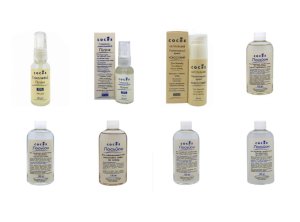 Most people use mechanical scrubs to exfoliate their skin at home, thinking that a chemical peel can be only done at a beauty salon by a qualified beautician. Well, this used to be true, but not any more. Today, cosmetic manufacturers offer safe, effective and affordable solutions for at-home chemical peels. One of such manufacturers is Cocos, a producer of handmade cosmetic products based in Odessa, Ukraine.
Most people use mechanical scrubs to exfoliate their skin at home, thinking that a chemical peel can be only done at a beauty salon by a qualified beautician. Well, this used to be true, but not any more. Today, cosmetic manufacturers offer safe, effective and affordable solutions for at-home chemical peels. One of such manufacturers is Cocos, a producer of handmade cosmetic products based in Odessa, Ukraine.
A chemical peel is a technique used to remove dead cells from the skin surface and reveal new, healthy skin using chemical exfoliating agents, such as alpha hydroxy acids (AHAs), beta hydroxy acids (BHAs) or retinoids. Chemical peels help to get rid of various skin imperfections, including acne spots, enlarged pores, pigmentation, and scarring caused by hyperkeratosis and demodicosis. Chemical peels also help to reduce wrinkles, boost collagen synthesis, improve skin elasticity and firmness, even out skin tone, and make the skin soft, smooth and supple.
There are three main types of chemical peel depending on the skin layer it affects: superficial peel, medium depth peel and deep peel. At-home peels are almost always superficial because this type of chemical peel is the safest. If you have plenty of experience with superficial peels you can try a medium depth peel at home, but it isn’t advisable. Deep peels must always be performed by a licensed beautician or dermatologist because there’s a high risk of skin damage.
Chemical facial peels are very effective and ensure a visible result after just a couple of procedures. However, exfoliating chemicals can cause skin damage even in low concentrations if not applied properly. It is very important to prep your skin for a chemical peel, use the right concentration of the peeling product, and take care of your skin afterwards to speed up recovery.
If you’ve never done a chemical peel before, you should help your skin to get used to acids. Cocos has developed special lotions containing low concentrations of AHAs and BHAs that don’t exfoliate the skin but help it build resistance, so that it won’t get irritated or damaged during the peel. Depending on your skin type and degree of sensitivity, you should start using a pre-peel lotion 2 to 4 weeks before the peel. Cocos offers several such lotions for different skin types.
The brand’s pre-chemical peel lotion for oily and problem skin contains aloe vera hydrolate, lactic acid, succinic acid, salicylic acid, malic acid, citric acid, glycolic acid, coltsfoot extract, arginine, lysine, glycine, panthenol and hyaluronic acid. Thanks to these ingredients, the lotion balances the epidermis, produces a very light exfoliating effect, unclogs pores, soothes minor inflammation and normalises sebum secretion.
Pre-chemical peel lotion for normal skin, in its turn, is formulated with alpha hydroxy acids, aloe vera hydrolate and hyaluronic acid. The main tasks of this lotion include hydrating the skin, speeding up the healing of minor skin injuries and soothing minor inflammation, preventing pigmentation and various complications after a chemical peel.
Finally, pre-chemical peel lotion for dry skin contains a mix of alpha and beta hydroxy acids, amino acids (arginine, lysine, glycine), glycerine, aloe vera hydrolate and aloe vera leaf gel. This lotion helps the peel to penetrate the skin evenly, prevents adverse skin reactions, stimulates collagen and elastin synthesis, moisturises dry skin and makes it smoother.
So, you’ve prepared your skin for a chemical peel using one of these lotions. Now what? The next step is choosing a chemical peel that’s just right for you. Cocos offers several chemical peels based on different acids and their combinations. Each peel comes in several varieties depending on the acid concentration.
Chemical peels offered by Cocos are formulated with glycolic acid, gluconolactone, mandelic acid, lactic acid, succinic acid, a mix of AHAs and BHAs, salicylic acid, ferulic acid, azelaic acid, resorcinol, and other active ingredients. The concentration of acids in the brand’s chemical peels can vary from 5% to 60%, depending on the skin type, level of skin sensitivity and skin problems they’re designed to solve.
5% chemical peels have a pH of 3.5. They can be used to test the skin’s sensitivity and prepare the skin for chemical peels with a higher concentration of acids. They’re also the mildest and safest option for those who’ve never tried a chemical peel before.
10-20% chemical peels are more effective, but they are still gentle enough. They are the perfect choice for those who are still discovering the wonderful world of at-home chemical peels. These peels delicately exfoliate the skin, make it smoother and lighter, prevent premature skin ageing, normalise sebum secretion and boost skin cell metabolism.
Cocos’s 30-40% chemical peels are designed for experienced users. They can be used for medium-depth at-home chemical peels. Finally, chemical peels with a concentration of 50% or higher are very strong. They are designed for deep exfoliation and must be used with extreme caution.
During your very first at-home chemical facial peel, you should use one of the mildest and safest products, such as mandelic or gluconolactone peel with a concentration of 5%, maximum 10%. And don’t forget to prep your skin before applying the peeling solution in order to increase its efficiency and prevent side effects.
First, you should remove dirt and make-up residue from your skin. You shouldn’t use soap for this because soap has an alkaline pH and therefore neutralises acids used in chemical peels. Cocos has created facial washes with a slightly acidic pH that are specifically designed to prepare your skin for a chemical peel, such as Sugar Facial Cleansing Gel and Facial Cleansing Gel with Salicylic Acid.
Having cleansed your skin, you need to remove any excess skin oil that may have been left to make it easier for the chemical peel to penetrate your skin. The easiest way is to use rubbing alcohol, but it is too harsh on the skin. Instead of 70% ethanol, try Pre-Chemical Peel Lotion for Instant Skin Preparation by Cocos. In addition to ethanol, it contains glycerine that prevents skin dehydration.
The next step is applying the chemical peel solution to your face. You can do it with a make-up sponge, a cotton swab, a flat make-up brush or simply your fingertips (Cocos chemical peels have a gel-like texture that makes them easy to apply). First, apply the product to your forehead, then to the sides of your face, cheeks, the area around the eyes (only if the acid concentration is 20% or lower), neck and chest.
After that, let the peel sit for some time to make it work. During the first couple of procedures, 1 or 2 minutes is enough. If your skin reacts well, you can start applying the peel for longer periods of time. However, you shouldn’t leave it on your skin for longer than 15 minutes. It is very important to monitor your skin’s condition during the entire procedure. Light redness, tingling and burning are okay, but if the skin is too red and the burning sensation is too strong, you must rinse the peel off immediately to prevent severe irritation and skin damage.
If there are no adverse skin reactions, you need to moisturise your skin 5 minutes after you’ve applied the product. You can use a wet towel or simply your fingertips. When the time is up, apply chemical peel neutraliser. Cocos has created a special neutraliser with an alkaline pH specifically for this purpose. It contains soothing, moisturising and anti-inflammatory ingredients that help the skin return back to normal as soon as possible.
Finally, wash your face with lukewarm water and apply thick soothing cream, for example, Post-Chemical Peel Lamellar Coconut Cream, which is also produced by Cocos. Chemical peels make the skin more vulnerable to UV radiation, so you should use sunscreen or moisturiser with SPF to protect your skin from sun damage after the peel.
To achieve a visible and long-lasting effect, you should do a chemical peel once a week for 2 or 3 months. After 10 to 12 procedures, give your skin a break. The best time to do chemical facial peels is autumn and winter, when the sun is the least active and the risk of UV damage is minimal. It will take your skin 1 to 3 days to heal after the procedure. During this time, you need to pay extra attention to hydration and protection against the environment.
At-home chemical facial peels with Cocos products are effective and affordable. The brand offers a wide choice of options for all skin types, so it’s very easy to pick a combination of products that works best for you. Of course, to achieve the best result and make your skin look youthful and glowing with health, you should strictly follow the manufacturer’s instructions.
